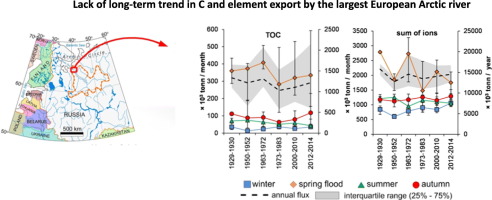当前位置:
X-MOL 学术
›
Chem. Geol.
›
论文详情
Our official English website, www.x-mol.net, welcomes your feedback! (Note: you will need to create a separate account there.)
High resolution multi-annual riverine fluxes of organic carbon, nutrient and trace element from the largest European Arctic river, Severnaya Dvina
Chemical Geology ( IF 3.9 ) Pub Date : 2020-04-01 , DOI: 10.1016/j.chemgeo.2020.119491 Artem V. Chupakov , Oleg S. Pokrovsky , Olga Y. Moreva , Liudmila S. Shirokova , Natalia V. Neverova , Anna A. Chupakova , Ekaterina I. Kotova , Taissia Y. Vorobyeva
Chemical Geology ( IF 3.9 ) Pub Date : 2020-04-01 , DOI: 10.1016/j.chemgeo.2020.119491 Artem V. Chupakov , Oleg S. Pokrovsky , Olga Y. Moreva , Liudmila S. Shirokova , Natalia V. Neverova , Anna A. Chupakova , Ekaterina I. Kotova , Taissia Y. Vorobyeva

|
Abstract Assessing multi-annual riverine export fluxes of carbon, nutrients and metals from the continent to the Arctic Ocean is crucial for constraining the current status and foreseeing future changes in riverine export induced by climate change. Over 3 consecutive years (2012–2014), we measured daily to weekly concentrations of C, N, P, all major and 45 trace elements (TE) in filtered ( The spring flood (May and June) provided 50% of overall water and DOC, V, Cr, Mn, Fe, Co, Ni, Cu, Zn, Cd, Sb, and Pb flux and 60% of low-soluble TE (Al, Y, Nb, REEs, Ti, Zr, Hf and Th). The nutrients (K, Rb, Si, P, N) exhibited around 40% share of annual export during spring flood, whereas the export of soluble mobile elements (DIC, Cl−, SO42−, Li, B, Na, Mg, Ca, Sr, Mo and U) mainly occurred during winter (35–40%) with only 20–25% of annual flow provided by spring flood. The 3-year mean export fluxes of dissolved components were 30 to 50% lower than (Ti, Cr, Mn, Fe, Co, Ni, Cu, Zn, Cu, Cd, and Pb) or comparable to (±30% for all other elements including DOC and for DIC) previous estimates of this river from 2007 to 2008 and the historic data of major components from 1930 to 1950. In particular, there was no trend in mean monthly seasonal and annual concentrations and export fluxes of DOC, DIC, SO4, Cl since the beginning of chemical analysis between 1929 and 1930 and in Ca, Mg, Si, and Fe since the 1950's through the duration of this study (2012–2014). The lack of seasonal and annual increases in discharge, carbon, and element concentrations in the permafrost-free Severnaya Dvina River for >120 years of discharge and over 60 years of chemical composition measurements is at odds with the reported short-term trend (based on measurements that began in 1970s) showing that element export fluxes increased in other Arctic rivers due to on-going climate warming and permafrost thaw. Novelty statement Historical and contemporary measurements of element fluxes in the largest European Arctic river did not reveal sizeable changes in discharge and DOC, DIC, Ca, Mg, Fe, Si, SO4, Cl concentrations and fluxes over past >60 years.
中文翻译:

来自欧洲最大的北极河流 Severnaya Dvina 的有机碳、营养物和微量元素的高分辨率多年河流通量
摘要 评估从大陆到北冰洋的碳、养分和金属的多年河流出口通量对于限制气候变化引起的河流出口的现状和预测未来变化至关重要。连续 3 年(2012-2014 年),我们每天到每周测量 C、N、P、所有主要和 45 种微量元素 (TE) 的过滤(春季洪水(5 月和 6 月)提供了 50% 的总水量和DOC、V、Cr、Mn、Fe、Co、Ni、Cu、Zn、Cd、Sb 和 Pb 助焊剂和 60% 的低溶解性 TE(Al、Y、Nb、REE、Ti、Zr、Hf 和 Th) . 春季洪水期间,养分(K、Rb、Si、P、N)在年出口中所占份额约为 40%,而可溶性移动元素(DIC、Cl−、SO42−、Li、B、Na、Mg、钙,锶,Mo 和 U) 主要发生在冬季(35-40%),春季洪水仅提供 20-25% 的年流量。溶解成分的 3 年平均出口通量比(Ti、Cr、Mn、Fe、Co、Ni、Cu、Zn、Cu、Cd 和 Pb)低 30% 至 50% 或与(所有成分的±30%)相当其他要素,包括 DOC 和 DIC) 2007 年至 2008 年对该河流的先前估计以及 1930 年至 1950 年主要成分的历史数据。特别是,DOC、DIC 的平均月季节性和年浓度以及出口通量没有趋势, SO4, Cl 自 1929 年至 1930 年开始进行化学分析以来,以及自 1950 年代以来一直到本研究期间(2012-2014 年)的 Ca、Mg、Si 和 Fe。无永久冻土的 Severnaya Dvina 河中的排放量、碳和元素浓度没有季节性和年度增长 > 120 年的排放量和 60 多年的化学成分测量结果与报告的短期趋势(基于 1970 年代开始的测量结果)不一致,表明由于持续的气候变暖和永久冻土,其他北极河流的元素出口通量增加解冻。新颖性声明 对欧洲最大的北极河流中元素通量的历史和现代测量并未揭示过去 60 年中排放量和 DOC、DIC、Ca、Mg、Fe、Si、SO4、Cl 浓度和通量的显着变化。
更新日期:2020-04-01
中文翻译:

来自欧洲最大的北极河流 Severnaya Dvina 的有机碳、营养物和微量元素的高分辨率多年河流通量
摘要 评估从大陆到北冰洋的碳、养分和金属的多年河流出口通量对于限制气候变化引起的河流出口的现状和预测未来变化至关重要。连续 3 年(2012-2014 年),我们每天到每周测量 C、N、P、所有主要和 45 种微量元素 (TE) 的过滤(春季洪水(5 月和 6 月)提供了 50% 的总水量和DOC、V、Cr、Mn、Fe、Co、Ni、Cu、Zn、Cd、Sb 和 Pb 助焊剂和 60% 的低溶解性 TE(Al、Y、Nb、REE、Ti、Zr、Hf 和 Th) . 春季洪水期间,养分(K、Rb、Si、P、N)在年出口中所占份额约为 40%,而可溶性移动元素(DIC、Cl−、SO42−、Li、B、Na、Mg、钙,锶,Mo 和 U) 主要发生在冬季(35-40%),春季洪水仅提供 20-25% 的年流量。溶解成分的 3 年平均出口通量比(Ti、Cr、Mn、Fe、Co、Ni、Cu、Zn、Cu、Cd 和 Pb)低 30% 至 50% 或与(所有成分的±30%)相当其他要素,包括 DOC 和 DIC) 2007 年至 2008 年对该河流的先前估计以及 1930 年至 1950 年主要成分的历史数据。特别是,DOC、DIC 的平均月季节性和年浓度以及出口通量没有趋势, SO4, Cl 自 1929 年至 1930 年开始进行化学分析以来,以及自 1950 年代以来一直到本研究期间(2012-2014 年)的 Ca、Mg、Si 和 Fe。无永久冻土的 Severnaya Dvina 河中的排放量、碳和元素浓度没有季节性和年度增长 > 120 年的排放量和 60 多年的化学成分测量结果与报告的短期趋势(基于 1970 年代开始的测量结果)不一致,表明由于持续的气候变暖和永久冻土,其他北极河流的元素出口通量增加解冻。新颖性声明 对欧洲最大的北极河流中元素通量的历史和现代测量并未揭示过去 60 年中排放量和 DOC、DIC、Ca、Mg、Fe、Si、SO4、Cl 浓度和通量的显着变化。



























 京公网安备 11010802027423号
京公网安备 11010802027423号